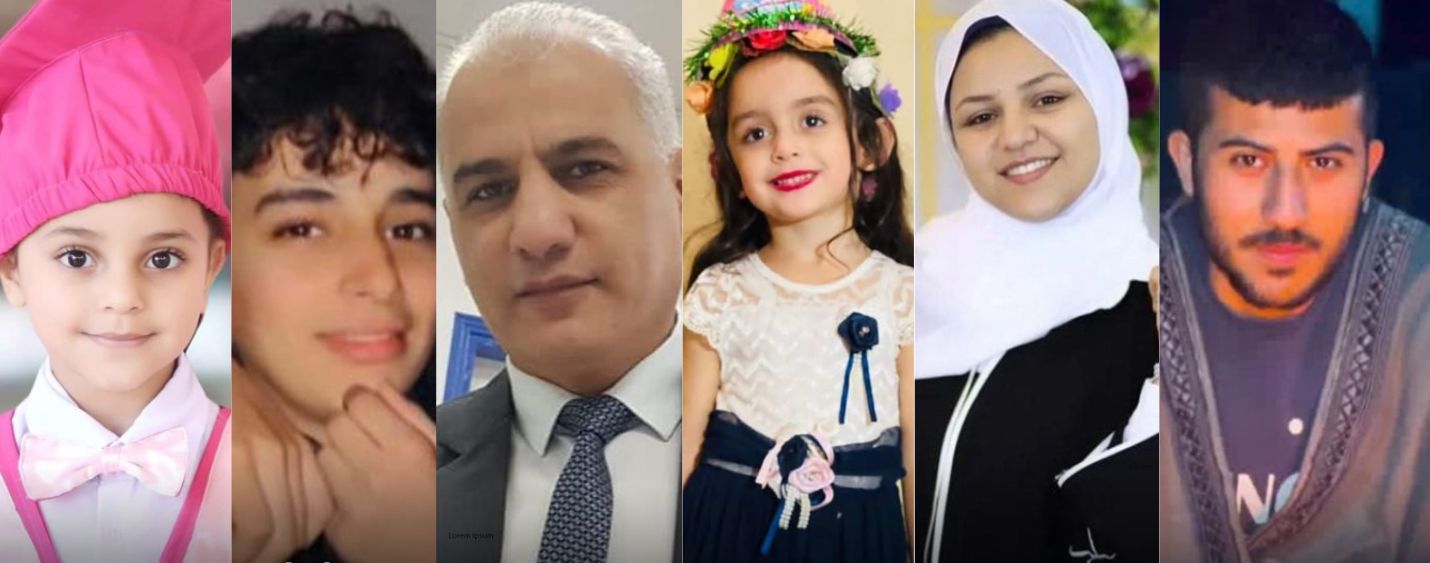Pictured above, left to right:
Luna Husam Abu Nada, Bahaa Al-Masahal, Nahid Abdul Latif, Jouri Ramadan Mohammed Maqdad, Nahil Sami Ma’mar,
Mamoud Duwaba.
*
As the gruesome deaths of Palestinians by hunger or drones fill our social media feeds but go largely unreported by mainstream media, The Martyrs of Gaza project is a needed antidote to the common way journalism dehumanizes the people actually being killed in the Gaza genocide by commission of omission.
Typically, journalism has a proclivity to overly rely upon the accounts of soldiers, military officers, and politicians in times of war—often of those who are doing the most killing. (Take for example the PBS NewsHour’s bizarre February story “Israeli soldier’s video diaries offer unique perspective on war in Gaza.”) This is a misdirection. As writer Viet Thanh Nguyen said in October,
I’ve spent a lot of time thinking about how the ramifications of war are oftentimes very visible for soldiers, because when we think about wars, we generally think of wars, soldiers, battles, tanks and so on, but the fact of the matter is that wars usually kill more civilians than soldiers. And civilians bear enormous burdens, both of violence but also of ongoing trauma in the years afterwards.
Nguyen said this after a reading of his Vietnamese migration memoir A Man of Two Faces had been canceled by the 92nd Street Y, because he had signed an open letter in the London Review of Books to “demand an end to the violence and destruction in Palestine.” The media depiction of people in Gaza, which has no military and where tens of thousands of civilians have been killed, is a particularly brutal example of civilian dehumanization by western media.
In the binaries determining whether journalists consider lives to be “grievable or ungrievable” as outlined by Judith Butler in Frames of War—or if reporters determine such lives are “worthy” and “unworthy” as designated by Edward Hermand and Noam Chomsky in Manufacturing Consent—mainstream American journalists and politicians have largely presented Palestinian deaths as both ungrievable and unworthy.
Deaths in Palestine are treated as numbers, if even that. In October, President Biden was asked about the thousands of civilian casualties, and he said he had “no confidence” and “no notion that the Palestinians are telling the truth about how many people are killed.”
“The stories, once liberated, reach a broader audience, fostering empathy… ‘Gaza Martyrs’ turns social media into an act of love.”A necessary intervention in this dehumanization of a people experiencing genocide is a project like the Martyrs of Gaza. With 142,000 followers on Twitter and 62,000 on Instagram, the social media endeavor memorializes, humanely and with compassion, Gazans killed during Israel’s assault—and will continue to do so, as long as the people running it in Gaza do not become martyrs themselves.
I spoke to the founder and lead writer of the four-person team behind Martyrs of Gaza, from a location in Gaza we are not sharing to protect her safety. After three attempts to speak by phone were thwarted by poor internet connection or intense bombing, most of our conversation was conducted by voice notes and text messages on WhatsApp. The interview has been very lightly edited for clarity.
*
Steven W. Thrasher: Thank you so much for talking to me. I am grateful for your work, and do not want to put you in any more danger than you already face. What would you like to say about who you are and your life, that will not compromise your safety?
Martyrs of Gaza: I’m Rozan, in my final year of university studying pharmacy. I have a small family that fills my life, but now our lives have been turned upside down due to the genocide we are facing.
ST: You write so beautifully in English. Are you a journalist? Or have you studied journalism in university? And if you are a journalist, did you ever write an “obituary” before?
MG: No, I’m not a journalist, but I love writing and reading stories, so you could say my writing is good. [A journalist shoots the original videos and some of the photographs on their feeds.]
ST: Please tell me about the Martyrs of Gaza project. How did you decide to do it?
MG: The genocide was shocking to all of us. For a moment, I thought none of us would survive. I cried a lot, fearing death without anyone remembering me. Hearing the news every day, claiming Israel killed 100, 200, 300, 1,000 Palestinians, was tough for me. These people had stories, dreams, and a normal life, contrary to Israel’s portrayal of them as terrorists. So, I decided to expose the falsehood of Israeli claims by writing about the real lives of the martyrs and how they were beautiful people.
ST: From a television show in America called Democracy Now!, I learned about Refaat Alareer before he died, and of his project, We Are Not Numbers. Like your project, I love how WANN humanizes people. Was it an inspiration for you?
MG: Our martyrs are not numbers; this has always been everyone’s statement in Palestine. We believe our martyrs deserve honor and remembrance. Dr. Refaat was an inspiration to everyone, and everyone agreed on their love for him.
ST: How do you find the stories and the pictures you write about?
MG: Stories are sent by close associates, be it family, friends, or colleagues. I receive them in Arabic and translate them into English. The impact of stories often moves me to tears, affecting my mental health due to immersion in their details. Yet, the joy arises when people engage with martyr stories, finding purpose in it.
“The scenes you see on screens or social media are just a fraction of the reality. There are even more horrific and tragic stories.ST: In America, I have artist friends who make a beautiful project called the Classroom of Compassion. Their motto is “I Hope You Know How Loved You Are.” They go to sites where terrible violence happens in America—such as the school shooting in Uvalde, Texas—and they make memorials of the people who were killed. One thing they do is find beautiful photos of the people who died and make them life-size, so people do not only know of their violent deaths, but see the beauty of their lives. Martyrs of Gaza also uses photos of people smiling and happy. How did you make the decision to depict people in this way?
MG: [We want to illustrate them] from their accounts and life before the war.
ST: I worked for an oral history project in America once called StoryCorp, where two friends or family members would come into a recording booth and ask each other questions. The motto of the project was “Listening is an Act of Love.” How do you think about the role of love in your work?
MG: The stories, once liberated, reach a broader audience, fostering empathy. Love, as seen in initiatives like StoryCorps, is a powerful force, and “Gaza Martyrs” turns social media into an act of love.
ST: The boy you interviewed on video a few weeks ago, the orphan who was selling things on the street, everyone in his family had died but his brother—he seemed so full of love. Do you know what happened to him?
Please give me 1:20 minutes of your time and listen to what this brave child from northern Gaza is going through.
Gaza’s children defy the circumstances after the world let them down. pic.twitter.com/wJoQDCwiBl
— Martyrs of Gaza (@GazaMartyrs) February 13, 2024
MG: Until now, no🥹
ST: I am sorry to hear that.
MG: I’m sorry but yes. The video is from northern Gaza, not Rafah. The boy lost his entire family, leaving him and his younger brother as the only survivors. He now supports his brother.
ST: I have a few final, related questions, then I want to turn this interview over to you. There is a word in Arabic which we do not have in English called, I believe, thakla (ثكلى). Can you explain what it means?
MG: This word refers to a mother who has lost her daughter or [son]. I’m not sure if there’s an equivalent term in English.
ST: I believe you are a thakla ثكلى. I was shocked, and touched, reading that your own beloved daughter, Noor, was murdered by Israel, backed by the United States. This is inadequate, but please let me offer my condolences. I am so sorry for this unimaginable loss. It touched my heart deeply to read your words, that “My life turned into an empty desert after her, despite the crowdedness around us.” Can you tell us about Noor? And how are you able to do such intense, important work helping others to remember their beloveds, when you have so much grief yourself?
MG: In reality, Noor is the daughter of my colleague who worked with me on the same project documenting the stories of martyrs. She continued working after this tragic incident, writing stories as a way to cope. We were all shocked by the news of Noor’s martyrdom, and her mother collapsed for a considerable period. She decided to continue working with me and write the stories, but it was very difficult for her until she eventually chose to stop writing and reading martyr stories as it took a toll on her mental health.
ST: My condolences to your colleague.
MG: 🥺
ST: Finally one last question from me, then I will turn it to you. I have seen on your account that you have been helping distribute aid to people. It feels so difficult to get money or aid into Gaza from America. What are you doing that is working? And how can our readers support your work?
MG: Beyond documenting stories, aiding displaced individuals in need of essentials like food and medicine is crucial. Readers can support by assisting displaced individuals facing daily hardships due to restricted access.
ST: Can readers make a donation to Martyrs of Gaza?
MG: Yes, sure. This helps us to do more and more for displaced people who live in the camps. [Donations can be made here.]
ST: Now, I want to turn it over to you. Is there anything you would like to ask me? Or that you would want to say to the people of the world? To the people of the United States?
MG: Firstly, thank you very much, Mr. Steve. It was a pleasure meeting you. I would like to say to the world, and to the American people specifically, that what we are facing is among the worst crimes in contemporary history. The scenes you see on screens or social media are just a fraction of the reality. There are even more horrific and tragic stories, and I hope everyone supports and stands with us. We are not as portrayed by the global media with political agendas. We are ordinary people who love life, peace, and have ambitions and a future.
ST: Thank you, Rozan. I am very touched by your words. Thank you very much for your time, and for everything you do. It is a gift to the martyrs, to the people who loved them, and to your readers around the world. I hope one day we can meet in a free Palestine. Until then, I wish blessings and safety to you and your family, my friend. Inshallah.
MG: I hope too❤️
_______________________
Donations can be made to Martyrs of Gaza to support their work via PayPal or Buy Me a Coffee.



